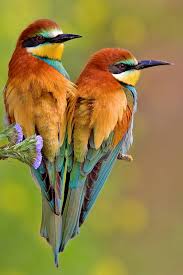 |
| A pair of European Bee-eaters |
Bee-eaters have slender bodies covered with vibrant feathers and are found mostly in Africa and Asia, with minor populations dotting in Europe and Australia. They are diurnal creatures unless their migratory path is interrupted by sea or unsuitable habitat.
As their name suggests, they prey upon flying insects, mostly bees and wasps. Honey bees turn out to be their favourite food and that alone constitutes 90% of all insects eaten. They remove the stinger from bees and wasps by hitting and rubbing the insect on hard surfaces continuously. Strangely enough, they only catch flying preys in the air, or "hawking". And once the flying insects land, the bee-eaters totally ignore them.
 |
| Dust-bathing |
Bee-eaters always use 10% of their day having fun, or known as "comfort activity". These activities include sun-bathing (to heat up their body), dust-bathing (to clean their body of parasites) and water-bathing (to bath)
 |
| "Zero distance" |
Bee-eaters live in colonies by nesting in burrows on the side of sand banks. Despite being in colonies, bee-eaters are strictly monogamous for one or more breeding seasons. Instead of pulling out a wedding ring, bee-eaters pull out their food to feed their mate, which is known as courtship feeding. After getting alone with each other, the pair begins digging their nest together by jabs of sharp bills and kicks from their tiny feet. Their home is rarely used twice and is considered unique. The love of these couple can also be observed by their "zero distance standing" where they stand so close to each other till their feathers touch.
 |
| "So, watcha lookin' at?" |
*Pictures obtained from Wikipedia and Google Image Search


No comments:
Post a Comment